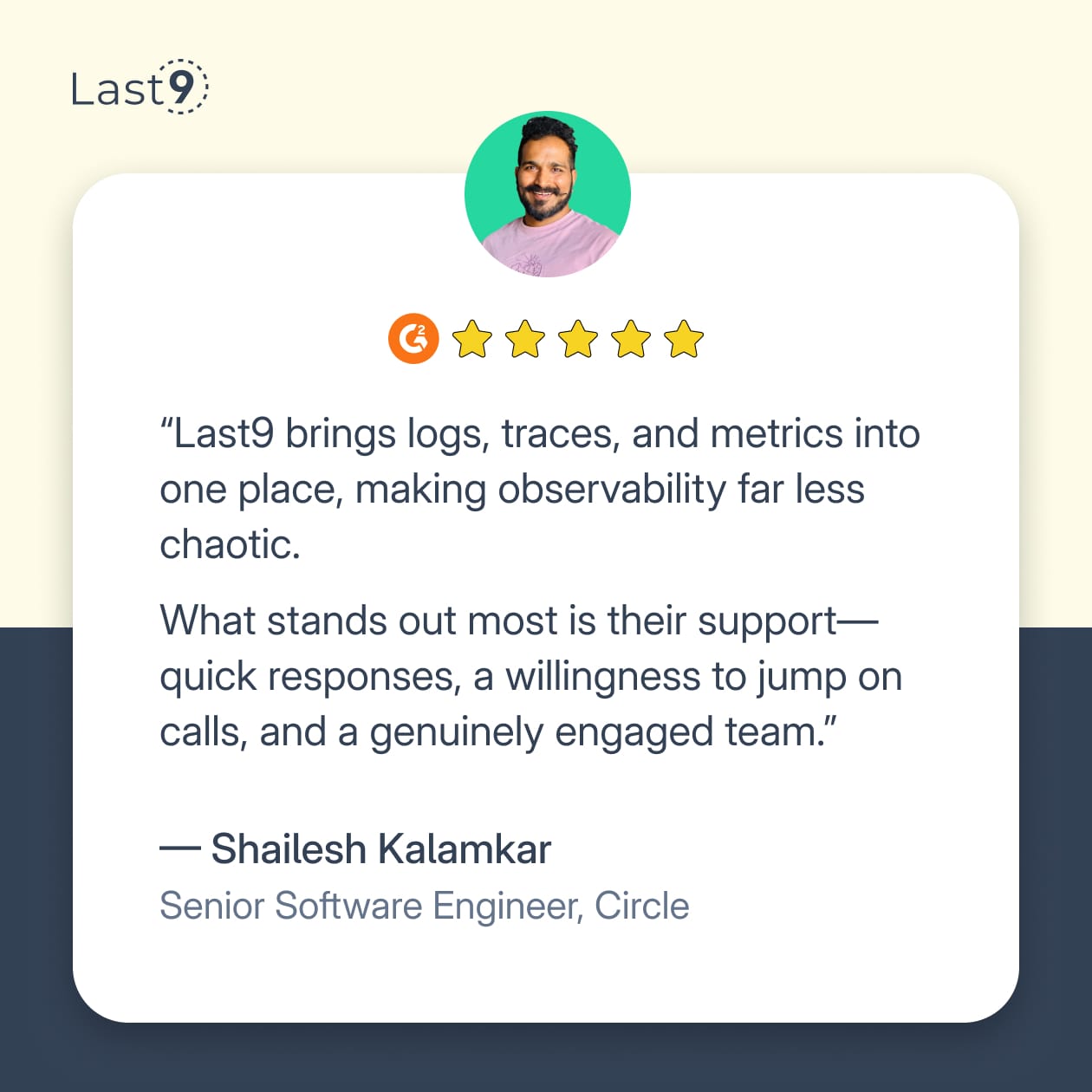Observability has become a core part of running Ruby applications at scale. Knowing how your app performs — from request latency to background job execution — helps catch slowdowns early and improve reliability.
This blog walks through some of the most useful APM tools for Ruby in 2025. Each section highlights what the tool does well, where it fits best, and what kind of visibility it brings to your application's performance.
What is an APM Tool?
An Application Performance Monitoring (APM) tool collects and analyzes telemetry from your application to measure how it performs under real workloads. It tracks metrics such as:
- Response time: How long each request takes to complete
- Throughput: The number of requests handled per second
- Error rate: The percentage of requests that fail
- Resource usage: CPU, memory, and I/O consumption
Modern APMs also include distributed tracing, allowing you to follow a request across services, queues, and background jobs. This data helps identify performance regressions, slow queries, or external dependencies affecting response times.
In short, an APM tool connects raw telemetry with context — giving you visibility into how your code behaves in production.
Why APM is Crucial for Ruby Applications
Ruby applications, particularly those built with Rails or Sidekiq, often involve multiple moving parts — controllers, background jobs, Active Record queries, and third-party APIs. Each layer can introduce latency or resource pressure if not monitored properly.
A good APM solution for Ruby should do three things well:
1. Surface Bottlenecks in Real Time
An APM agent instruments your code, tracing requests from controller to database. For example, it can show how much time a request spends in ActiveRecord, Redis, or an external HTTP call. When response times increase, you can immediately see whether the delay originates from slow SQL queries, a blocked thread, or a downstream service.
Last9, Datadog, and similar tools expose this breakdown through transaction traces, giving you a millisecond-level view of where latency accumulates.
2. Detect and Resolve Issues Early
Instead of waiting for logs or user complaints, APM tools continuously monitor application health through configurable thresholds and anomaly detection.
For instance, if a Sidekiq queue latency crosses a set threshold or an API endpoint's error rate spikes, the system can trigger alerts to PagerDuty or Slack.
This proactive layer helps you maintain uptime and reduce mean time to detect (MTTD).
3. Optimize Resource Utilization
Ruby's garbage collection and dynamic runtime can create unpredictable CPU and memory usage. APM metrics expose these patterns, helping you fine-tune Puma workers, database connection pools, or caching layers.
If you notice a specific job consuming excessive CPU or memory, APM data makes it easier to profile and optimize the code path instead of over-provisioning servers.
Top 11 Ruby APM Tools Worth Checking in 2025
Choosing the right APM tool shapes how effectively you can monitor, debug, and scale your Ruby applications. Below are 11 options worth evaluating in 2025, built on reliability engineering principles and OpenTelemetry-native observability.
1. Last9
Last9 - If you're running Ruby or Rails applications in production, Last9 helps you see exactly how your systems behave — from incoming requests to database queries and background jobs. It's designed for teams that want detailed visibility without the noise or storage overhead that comes with traditional APM tools.
Here's how it fits into your Ruby stack:
OpenTelemetry-native setup
You can instrument your Ruby services using the official opentelemetry-ruby SDK and send traces, metrics, and logs directly to Last9. No proprietary agents or custom exporters — just open standards that work across Rails, Sidekiq, or Sinatra.
High-cardinality metrics at scale
Ruby apps often emit a large number of unique series per controller, endpoint, or tenant. Last9 has been put to the test to handle millions of these without dropping data. This means you can analyze latency per user, plan, or region and still maintain query performance.
Streaming aggregation for real-time insights
You can monitor live request latencies or job failures as they happen, not minutes later. Streaming aggregation lets you detect spikes instantly, making it easier to debug production behavior.
Early reliability signals
Instead of reacting after a slowdown, Last9 correlates latency, errors, and resource metrics to flag patterns that usually precede an outage. You get a clear view of what's changing before it becomes a customer issue.
Built-in cost control
Observability costs tend to rise as your telemetry grows. Last9 helps you retain precision while reducing overhead through cardinality-aware aggregation and flexible retention policies.
If you're already using OpenTelemetry or planning to standardize on it, Last9 gives you a clean, scalable path to production-grade observability without the usual trade-offs.
As a telemetry data platform, we've monitored 11 of the 20 largest live-streaming events in history, ensuring real-time insights without unnecessary overhead.

2. AppSignal
AppSignal - If you're looking for an APM tool built specifically for Ruby developers, AppSignal is one of the most polished options out there. It's easy to set up, yet detailed enough to help you track every request, background job, and external dependency in production.
Here's how AppSignal helps you monitor your Ruby applications:
Seamless Ruby integration
AppSignal has first-class support for Ruby and Rails. You can install it with a single gem (gem 'appsignal') and get automatic instrumentation for common frameworks like Sidekiq, Puma, and Active Record — no manual setup required.
Detailed transaction traces
Every request and job gets a full performance breakdown, showing time spent in each controller action, database call, or HTTP request. You can identify slow endpoints or queries in seconds, making it easier to focus your optimization efforts.
Error and exception tracking
AppSignal automatically captures unhandled exceptions, background job failures, and slow queries. You get detailed stack traces, affected users, and contextual parameters so you can reproduce and fix issues faster.
Host and process metrics
Beyond application-level data, AppSignal also tracks CPU, memory, and disk usage on the host. This helps you correlate infrastructure behavior with code performance — especially useful if your Ruby apps share resources across services.
Built-in anomaly detection
You can define custom alerts or rely on AppSignal's automatic anomaly detection to notify you when response times, error rates, or queue lengths drift from normal behavior.
AppSignal strikes a solid balance between simplicity and depth — you get a clean UI, automatic instrumentation, and enough context to debug performance regressions without wading through raw telemetry.
3. Scout APM
Scout APM - Scout APM is built specifically for Ruby and Elixir applications, with a focus on clarity and actionable insights. It helps you trace slow endpoints, detect inefficient queries, and identify memory growth patterns — all without overwhelming you with unnecessary data.
Here's how Scout APM supports Ruby teams:
Easy setup for Ruby frameworks
Installation is straightforward — add the scout_apm gem, and Scout automatically instruments Rails, Sinatra, and background job systems like Sidekiq and Resque. You start seeing traces and performance data as soon as your app runs.
Detailed transaction breakdowns
Each web request or background job is analyzed to show time spent in controller actions, ActiveRecord queries, and external HTTP calls. This level of detail makes it easier to locate where latency is introduced.
N+1 query and memory bloat detection
Scout flags inefficient query patterns and highlights memory usage anomalies. It's particularly effective for catching gradual performance drift caused by heavy allocations or growing datasets.
Clean and focused dashboards
Instead of displaying hundreds of metrics, Scout emphasizes what matters most — slow transactions, query-heavy endpoints, and the largest sources of memory pressure.
Deployment tracking
Each deployment is automatically tagged, so you can correlate performance regressions with recent code changes and rollbacks if needed.
Scout APM combines a low-friction setup with detailed visibility, making it a practical choice for teams that want to maintain performance visibility across Ruby services without extra overhead.
4. Sentry
Sentry - Sentry started as an error monitoring tool, but its performance monitoring features now make it a strong option for Ruby applications as well. It gives you both sides of the picture — what failed, and how performance was affected.
Here's how Sentry helps you monitor Ruby applications more effectively:
Unified error and performance tracking
Sentry captures unhandled exceptions, slow transactions, and bottlenecks within your Ruby application. You can see which routes, queries, or background jobs correlate with spikes in latency or error rates.
Granular trace data
Each transaction trace shows where time is spent — from controller execution to database calls and external API requests. This helps you connect a specific performance issue to its root cause.
Context-rich error reports
When an error occurs, Sentry provides detailed stack traces, request parameters, environment details, and affected user information. This makes it easier to reproduce and fix issues quickly.
Performance issue grouping
Sentry groups related slow transactions and errors, so you can identify recurring problems like inefficient queries or slow external dependencies without manually sorting through alerts.
Tight CI/CD integration
You can connect Sentry with GitHub or GitLab to link performance regressions directly to recent commits or releases, helping you pinpoint when a slowdown started.
Sentry's biggest advantage for Ruby teams is context — you see not just that something broke, but how that failure affected performance and user experience.
5. Datadog
Datadog - Datadog is one of the most widely used APM platforms, known for combining application, infrastructure, and log monitoring in a single place. For Ruby applications, it provides detailed request traces, runtime metrics, and integration with nearly every part of your stack — from web servers to background jobs.
Here's how Datadog fits into your Ruby workflow:
Comprehensive Ruby support
The ddtrace gem provides automatic instrumentation for popular frameworks and libraries like Rails, Sinatra, Sidekiq, and ActiveRecord. Once installed, you can see detailed traces for each request, including time spent in controllers, queries, and external services.
End-to-end distributed tracing
Datadog lets you follow a single request across microservices, queues, and databases. This makes it easier to identify where latency originates — for example, a slow downstream API or a blocking job in Sidekiq.
Code-level performance visibility
Beyond basic metrics, Datadog's profiler continuously samples Ruby code execution to show which methods consume the most CPU or memory. This helps you understand how performance changes with each deployment.
Unified observability
Because Datadog integrates metrics, traces, and logs, you can correlate a performance spike with a specific infrastructure event or log pattern. This unified view reduces the time spent switching between tools when debugging production issues.
Rich dashboards and alerting
You can build dashboards that track p95 latency, error rates, and throughput, then create alerts based on thresholds or anomalies. These alerts can integrate directly with tools like Slack or PagerDuty.
If you're already using Datadog for infrastructure or logs, extending it to APM for Ruby services provides a consistent, centralized view of performance and reliability. See Datadog's Ruby APM documentation!
6. Elastic APM
Elastic APM - Elastic APM extends the Elastic Stack to application monitoring, combining the flexibility of open source with full observability features. If you already use Elasticsearch and Kibana, it lets you monitor Ruby applications within the same ecosystem — with full control over data storage, visualization, and retention.
Here's how Elastic APM helps you monitor Ruby applications:
Native Ruby agent
The elastic-apm gem instruments Rails, Sinatra, and other Rack-based apps automatically. Once installed, it captures transactions, spans, and errors and ships them to your APM Server or directly to Elasticsearch.
Detailed transaction traces
Each request or background job is broken down into spans — database queries, external HTTP calls, or internal method calls — so you can pinpoint where latency originates. You can view these traces in Kibana for precise performance analysis.
Distributed tracing across services
Elastic APM supports W3C trace context, allowing you to trace requests that move between Ruby services, APIs, and external systems. This helps identify bottlenecks in multi-service architectures.
Error and exception tracking
When exceptions occur, Elastic APM records detailed stack traces, request parameters, and contextual metadata, helping you correlate specific code paths with error frequency.
Open-source flexibility
Since it's part of the Elastic Stack, you can customize everything — retention policies, data pipelines, and visualizations. This makes it ideal if you want full control over your observability setup rather than relying on a SaaS vendor.
Elastic APM works best when you already use the Elastic Stack for logging or search. It gives you a unified, self-managed view of your Ruby application's performance and reliability without vendor lock-in.
7. Instana
Instana - Instana is designed for teams running Ruby applications in dynamic or containerized environments. It automatically detects your services, instruments them, and starts collecting telemetry with minimal setup. If you're managing a microservices-based Ruby stack, Instana helps you keep track of how each service behaves — and how changes in one affect the rest.
Here's how Instana supports Ruby applications:
Automatic discovery and instrumentation
The instana gem automatically instruments Ruby frameworks like Rails, Sinatra, and Sidekiq. Once deployed, it discovers endpoints, background jobs, and dependencies without requiring manual configuration.
Real-time distributed tracing
Instana traces every request across services, databases, and external APIs, showing you the full execution path. You can view latency at each hop — from a Rails controller to PostgreSQL to Redis — in near real time.
Dynamic dependency mapping
As your application scales or services are redeployed, Instana continuously updates its dependency map. This visual model helps you see how Ruby services connect with APIs, message queues, or cloud infrastructure.
Contextual root-cause analysis
When performance degrades, Instana correlates metrics, traces, and logs to isolate the component causing the slowdown. For instance, you might see that increased latency in a Ruby API aligns with high CPU usage on a dependent service.
Strong Kubernetes and cloud support
Instana integrates with container orchestrators and cloud platforms, making it easier to monitor Ruby workloads that run in Kubernetes or ECS without additional setup.
Instana's key advantage lies in automation — it reduces the manual effort of setting up instrumentation while still giving you detailed, context-aware visibility into your Ruby services.
8. Prometheus (with Ruby Exporters)
Prometheus - Prometheus isn't a traditional APM tool, but with the right Ruby exporters, it becomes a powerful foundation for performance monitoring. It's best suited for teams that prefer building observability in-house — collecting precise metrics, storing them efficiently, and analyzing trends using PromQL.
Here's how you can use Prometheus for Ruby applications:
Metric collection via exporters
The prometheus-client Ruby gem lets you instrument Rails, Sinatra, or custom Ruby services. You can expose metrics such as request duration, queue latency, database query time, and cache hit ratios at /metrics endpoints for Prometheus to scrape.
Custom metric definitions
You can define your own counters, gauges, and histograms to track application-level events like job retries, API latency per endpoint, or memory usage per worker. This gives you full control over what telemetry is collected and how it's labeled.
Flexible querying with PromQL
PromQL allows you to create precise queries — for example, calculating p95 request latency or identifying the endpoints with the highest error rates. You can use these expressions in Grafana dashboards or as alert triggers.
Integration with tracing systems
Prometheus can be combined with tools like Grafana Tempo or the OpenTelemetry Collector to add distributed tracing to your metrics data. This helps you connect performance metrics with actual request paths across Ruby services.
Scalable and open-source
Prometheus runs as a self-hosted system, giving you complete control over data retention, federation, and alert routing. It's a good fit if you already manage infrastructure and want to avoid vendor lock-in.
When extended with Ruby exporters and visualization tools like Grafana, Prometheus offers deep visibility and flexibility — ideal for developers who want to define exactly how their performance data is collected and used.
9. Skylight
Skylight - Skylight is purpose-built for Ruby on Rails applications. It focuses on giving you precise, actionable visibility into how your app performs — without the overhead of a heavy monitoring setup. It's lightweight, easy to install, and built to highlight the performance issues that matter most in Rails environments.
Here's how Skylight helps you optimize your Ruby on Rails apps:
Rails-first instrumentation
Add the skylight gem to your Rails app, and it automatically instruments controller actions, database queries, and background jobs. You'll start seeing performance traces within minutes of deployment.
Action-level performance breakdowns
Each controller action is analyzed to show time spent in rendering, database access, and external API calls. Skylight presents this as a simple, visual flamegraph so you can spot bottlenecks quickly.
N+1 query detection and slow query insights
Skylight identifies inefficient ActiveRecord usage — such as N+1 queries — and helps you trace them back to specific lines of code or partials. You can fix these issues before they start affecting response times in production.
Low-overhead monitoring
The agent is optimized for minimal runtime impact, making Skylight suitable even for apps running on limited resources or high-traffic environments.
Developer-friendly reporting
The interface is built around clarity — you get clear call trees, response time distributions, and actionable suggestions instead of raw telemetry.
If you're running a Rails monolith or API and want quick visibility into what's slowing requests, Skylight gives you focused, Rails-native insights without requiring complex configuration.
10. Grafana
Grafana - Grafana is widely known as a visualization and analytics layer for metrics, logs, and traces — and it works exceptionally well when combined with Ruby exporters, Prometheus, or OpenTelemetry. While Grafana itself isn't an APM agent, it's often the front-end where you view and analyze your Ruby application's performance data.
Here's how Grafana supports performance monitoring for Ruby applications:
Unified observability dashboards
You can connect Grafana to Prometheus, Tempo, Loki, or Last9 to visualize Ruby metrics and traces in one place. This lets you track request latency, error rates, and background job performance alongside infrastructure metrics.
OpenTelemetry compatibility
If you're instrumenting your Ruby app with OpenTelemetry, you can send data through the Collector and visualize it directly in Grafana. This provides distributed tracing, logs, and metrics within a single UI — ideal for debugging complex interactions across Ruby services.
Powerful querying with PromQL and LogQL
Grafana supports PromQL for metrics and LogQL for logs, allowing you to build precise panels — for example, visualizing p95 latency per endpoint, job queue depth, or memory usage across Ruby processes.
Alerting and anomaly detection
You can define alert rules that trigger when Ruby service latency exceeds thresholds or when error rates spike. Alerts can integrate with Slack, PagerDuty, or email for real-time notifications.
Plugin ecosystem
Grafana's flexibility extends through plugins that connect to cloud platforms, tracing systems, and databases — giving you visibility beyond the Ruby layer.
Grafana shines as the visualization and control plane for observability data. When paired with Prometheus, OpenTelemetry, or Last9, it gives you an end-to-end view of how your Ruby applications behave — from metrics to traces — in a clean, customizable interface.
11. OpenTelemetry (Ruby SDK + Collector)
OpenTelemetry - OpenTelemetry has become the foundation of modern observability. Instead of being a standalone APM tool, it's a framework for generating, collecting, and exporting telemetry — metrics, traces, and logs — from your Ruby applications to any backend you choose.
Here's how you can use OpenTelemetry for Ruby monitoring:
Native Ruby instrumentation
The opentelemetry-ruby SDK provides automatic instrumentation for frameworks like Rails, Sinatra, and Sidekiq. You can install language-specific instrumentation packages (opentelemetry-instrumentation-active_record, opentelemetry-instrumentation-http, etc.) to capture latency, query times, and external call performance.
Custom spans and attributes
Beyond automatic instrumentation, you can create custom spans in your code to trace business logic or custom libraries. This gives you precise visibility into what matters in your application, such as user logins, job queues, or API workflows.
Collector for pipeline control
The OpenTelemetry Collector acts as a central pipeline between your Ruby app and your backend — whether that's Last9, Grafana Tempo, Datadog, or Elastic APM. You can configure processors to batch, filter, or sample data before exporting it, keeping telemetry volume manageable.
Vendor-agnostic observability
Because it uses the OpenTelemetry Protocol (OTLP), you're free to choose any backend for visualization and storage. This makes it easy to experiment or migrate without rewriting instrumentation.
Community and ecosystem support
The Ruby SDK is actively maintained and follows the same semantic conventions as other languages. That means consistent span names, attributes, and metrics across polyglot environments.
If you prefer full control over how telemetry flows through your system, OpenTelemetry is the most flexible way to instrument Ruby. It's the layer every modern APM or observability platform builds on.
Choosing the Right APM Tool for Your Ruby Application
Selecting an APM tool for a Ruby stack isn't just about dashboards — it's about understanding how telemetry flows through your systems, how the data scales, and how quickly it helps you isolate performance regressions. The right choice depends on your runtime architecture, deployment model, and level of observability maturity.
1. Define Your Monitoring Objectives
Start by identifying the telemetry signals that matter most to your workflows.
If you're operating a Rails monolith, focus on transaction-level tracing, SQL latency, and memory profiling. Tools like Skylight or AppSignal provide rich request-level visibility with minimal setup.
For distributed or service-oriented systems, prioritize context propagation and distributed tracing. OpenTelemetry, Last9, or Datadog can trace a single request across Sidekiq jobs, external APIs, and message queues, giving you a complete view of where time is spent.
Consider:
- Do you need to trace background jobs and async workers, not just web requests?
- Are N+1 query detection and GC profiling critical for your workload?
- Do you require real-time alerting or prefer batch analysis through logs and metrics?
Being specific about your telemetry goals helps align tool selection with measurable outcomes.
2. Evaluate Integration Overhead
Each APM introduces different levels of instrumentation complexity.
Some use simple Ruby gems with auto-patching (like AppSignal or Scout), while others require OpenTelemetry SDK configuration, environment variables, or collector pipelines.
When evaluating integration:
- Check framework support — Rails, Sinatra, or Hanami compatibility.
- Inspect agent runtime impact — memory footprint, thread blocking, or added latency.
- Validate deployment patterns — can the agent run inside your container, or does it require a sidecar or gateway?
- Ensure CI/CD compatibility — does the agent auto-inject during deploys or require manual setup per environment?
The best APM fits your delivery model without introducing friction or performance overhead.
3. Assess Scalability and Data Fidelity
As Ruby services scale, trace and metric volumes can increase exponentially. The APM must be able to process this growth without losing granularity.
Evaluate:
- Trace sampling strategy: Does it support head-based, tail-based, or adaptive sampling?
- Metric cardinality limits: Can it handle high-label metrics like per-endpoint or per-tenant breakdowns?
- Storage and retention policies: How efficiently can the system store and query months of telemetry?
- Aggregation pipeline: Does it offer real-time streaming (like Last9) or batch ingestion?
For production-grade systems, cardinality management and query latency under scale are just as important as the metrics themselves. Tools like Last9, Datadog, and Elastic APM handle high-cardinality data natively, while Prometheus or OpenTelemetry give you control through custom exporters and filters.
4. Plan for Long-Term Operability
Beyond metrics collection, consider how the tool fits your broader reliability goals:
- Can it integrate with your incident management and alert routing systems?
- Does it support SLO tracking and burn rate alerts out of the box?
- How easily can you extend instrumentation to new services or libraries?
APM tooling should evolve with your architecture — from a single Rails app to a distributed service mesh — without rewriting instrumentation. OpenTelemetry and Last9's OTLP-native architecture offer long-term flexibility for that transition.
Choosing an APM for Ruby isn't a one-time decision — it's a design choice that affects how quickly you can detect regressions, scale observability, and maintain performance budgets over time.
Final Thoughts
The Ruby ecosystem continues to mature, and so do the tools that help you observe and optimize it. If you prefer an open-source stack using Prometheus and OpenTelemetry or a full telemetry platform like Last9, the goal is the same — clear visibility into performance, faster troubleshooting, and fewer unknowns in production.
If you’re instrumenting Ruby services with OpenTelemetry, start your free trial on Last9 or set up a time with our team to explore how we can help you ship reliable systems at scale.
FAQs
How do you monitor application performance?
You can monitor Ruby application performance by collecting telemetry across three key layers:
- Metrics — Track response times, throughput, error rates, and resource usage (CPU, memory, I/O).
- Traces — Follow individual requests across controllers, background jobs, and external APIs.
- Logs — Capture contextual information to debug errors and latency patterns.
Tools like Last9, Datadog, or AppSignal handle metrics and traces automatically, while open-source options like Prometheus and OpenTelemetry let you define custom instrumentation for finer control.
What is the difference between APM and SRE?
APM (Application Performance Monitoring) focuses on real-time measurement of application behavior — latency, errors, and throughput.
SRE (Site Reliability Engineering) is a discipline that uses APM data to improve system reliability through practices like SLOs, alerting policies, and incident response.
In short, APM provides the data, while SRE defines how that data drives reliability decisions.
What is the best APM tool?
There isn't a single "best" APM tool — it depends on your use case:
- For open-source flexibility: OpenTelemetry + Prometheus + Grafana.
- For deep Ruby integration: AppSignal or Scout APM.
- For full-stack observability: Last9 or Datadog.
- For self-managed monitoring: Elastic APM or Grafana Tempo.
The right tool balances your needs for visibility, control, and scalability.
Is New Relic still the best way to monitor Rails apps, or are there better alternatives?
New Relic remains popular, but alternatives like Last9, AppSignal, and Datadog offer more modern tracing pipelines, better pricing control, and native OpenTelemetry support. If you prefer SaaS simplicity, New Relic and Datadog work well. If you want open standards or lower vendor lock-in, consider OpenTelemetry + Last9 for production-grade observability.
How many milliseconds should trigger a warning or alert in Elastic, Sidekiq, or Sinatra?
There's no single threshold — it depends on your SLA and workload type.
However, good starting points are:
HTTP request latency (Sinatra/Rails):
- Warning: >300 ms, Alert: >1 s
Elasticsearch query latency:
- Warning: >500 ms, Alert: >2 s
Sidekiq job processing time:
- Warning: >2 s, Alert: >5 s
You can fine-tune these thresholds using percentile-based alerts (p95, p99) to reflect real traffic behavior instead of averages.
Do you have any recommendations for ways to monitor or audit a Rails app for performance issues?
Yes. Combine profiling, tracing, and metric instrumentation:
- Enable APM tracing (Last9, AppSignal, or Datadog) for request-level visibility.
- Use rack-mini-profiler or ruby-prof in staging to identify slow controller actions.
- Track GC metrics (
GC::Profiler.enable) and memory growth over time. - Monitor SQL queries via ActiveSupport instrumentation and slow-query logs.
- Benchmark async jobs using Sidekiq middleware metrics or OpenTelemetry instrumentation.
This layered approach gives both real-time and historical visibility into Rails performance.
Is it safe to run Scout alongside my current APM library?
Running two APM agents simultaneously isn't recommended. Both tools may attempt to instrument the same frameworks (e.g., ActiveRecord, Net::HTTP), which can cause duplicate traces or data conflicts. If you want to compare tools, run them in separate environments or use sampling-based testing before deciding which to keep in production.
What kind of integrations does Scout support?
Scout APM integrates with:
- Frameworks: Rails, Sinatra, Padrino
- Background job systems: Sidekiq, Resque, Delayed Job
- Databases: PostgreSQL, MySQL, Redis
- Deployment tools: Heroku, AWS, Docker
It also offers webhook and API integrations for alerting or metric export to other systems.
What kind of APM data does Honeybadger collect?
Honeybadger focuses on error monitoring rather than full APM. It collects:
- Exception traces
- Context (request parameters, environment, user info)
- Uptime and heartbeat checks
- Basic performance data (response times and throughput)
For deeper tracing or metrics, it's often paired with a dedicated APM like AppSignal or Datadog.
How can I optimize the performance of my Ruby on Rails application using APM tools?
- Instrument controllers and background jobs to identify slow actions.
- Analyze N+1 queries and caching gaps surfaced in your APM traces.
- Use transaction traces to detect high GC or memory-bound operations.
- Correlate APM metrics with infrastructure telemetry (CPU, memory) for better root cause analysis.
- Set percentile-based alerts (p95, p99) for real latency visibility.
Over time, APM data helps you tune worker counts, adjust database indices, and optimize query plans.
How can I improve the performance of my Ruby application using monitoring tools?
Use a mix of tools that cover different layers:
- Prometheus or Last9 for system and runtime metrics.
- OpenTelemetry for request tracing and context propagation.
- Loki or ELK stack (Elasticsearch, Logstash, Kibana) for log correlation.
- AppSignal or Scout for code-level profiling.
The key is correlation — connecting metrics, logs, and traces to understand why latency occurs, not just where.



